Key takeaways
- Mill’s Harm Principle emphasizes that individual freedom should only be limited to prevent harm to others, prompting deep reflection on the balance between personal autonomy and societal impact.
- The concept of harm is multifaceted, encompassing physical, emotional, and social dimensions, which complicate how we define and address restrictions on liberty.
- In education, applying Mill’s principle involves a careful balance between allowing free expression and safeguarding students’ well-being, particularly against subtle harms like bullying.
- The principle encourages ongoing dialogue about the justification for limiting freedom, advocating for thoughtful and compassionate discussions about harm and liberty in society.
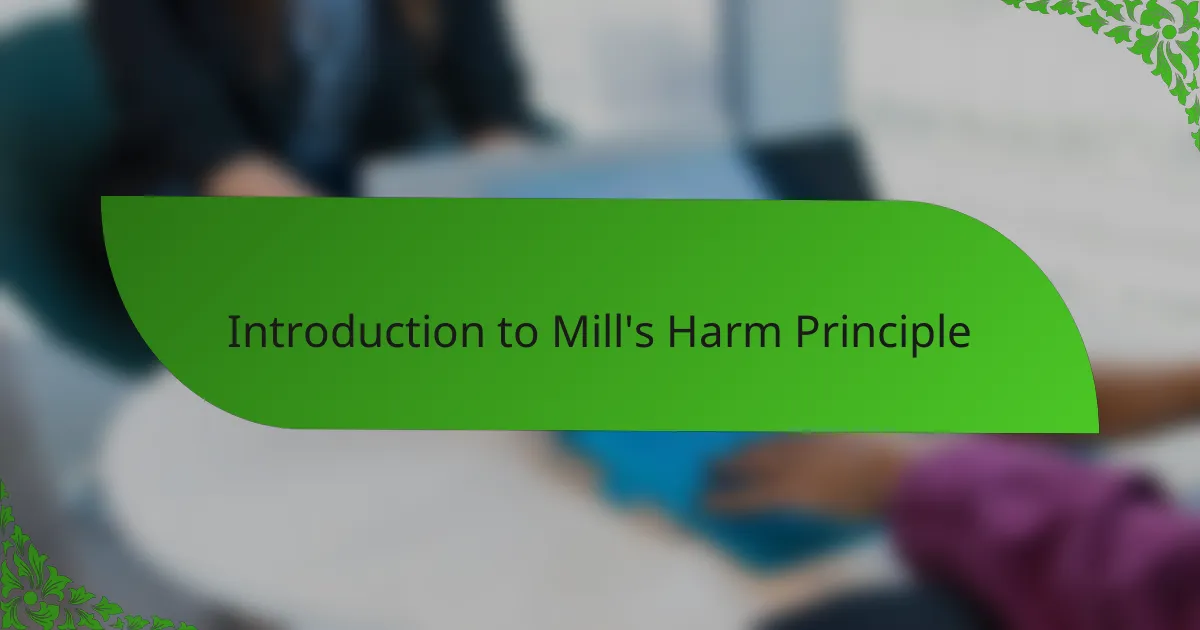
Introduction to Mill’s Harm Principle
When I first encountered Mill’s Harm Principle, I was struck by its simplicity and power: the idea that individual freedom should only be limited to prevent harm to others. It made me wonder—how often do we justify restrictions on liberty without truly considering who is harmed and to what extent? This principle challenges us to think deeply about the balance between personal autonomy and societal control.
Reflecting on my own experiences, I see how this principle plays out in everyday decisions. For instance, when someone chooses to engage in a risky hobby, like mountain climbing, should others interfere simply because it endangers themselves? Mill’s idea suggests not, unless that risk somehow imposes harm on others, which feels like a fair and respectful approach to freedom.
What fascinates me most is how this principle encourages ongoing conversations about ethics and governance. It asks us to question: when is it right to step in, and when should we step back? This question remains incredibly relevant, especially in a world where personal choices often have wider social implications.
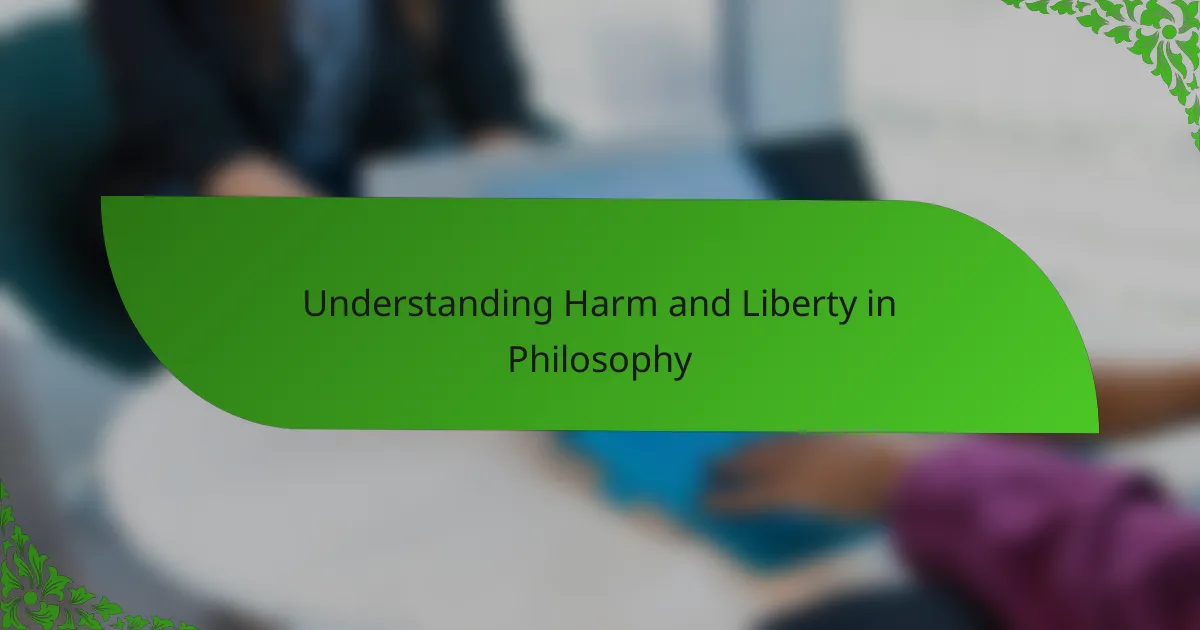
Understanding Harm and Liberty in Philosophy
When I think about harm in philosophy, I realize it’s not always straightforward. What exactly counts as harm? Is it only physical injury, or can emotional and social damages qualify too? Mill’s idea made me question my own assumptions—sometimes we overlook subtle harms because they aren’t as visible.
Liberty feels like a natural right to me, yet I’ve seen situations where unlimited freedom leads to chaos or injustice. How do we hold onto personal liberty without stepping on others’ rights? That ongoing tension is what makes the discussion about harm and liberty so alive and pressing.
In my experience, conversations about freedom often reveal more about our values than our laws. I remember debating with friends whether censorship is ever justified. Those talks reminded me that understanding harm and liberty is less about fixed answers and more about exploring the nuances that define our moral boundaries.
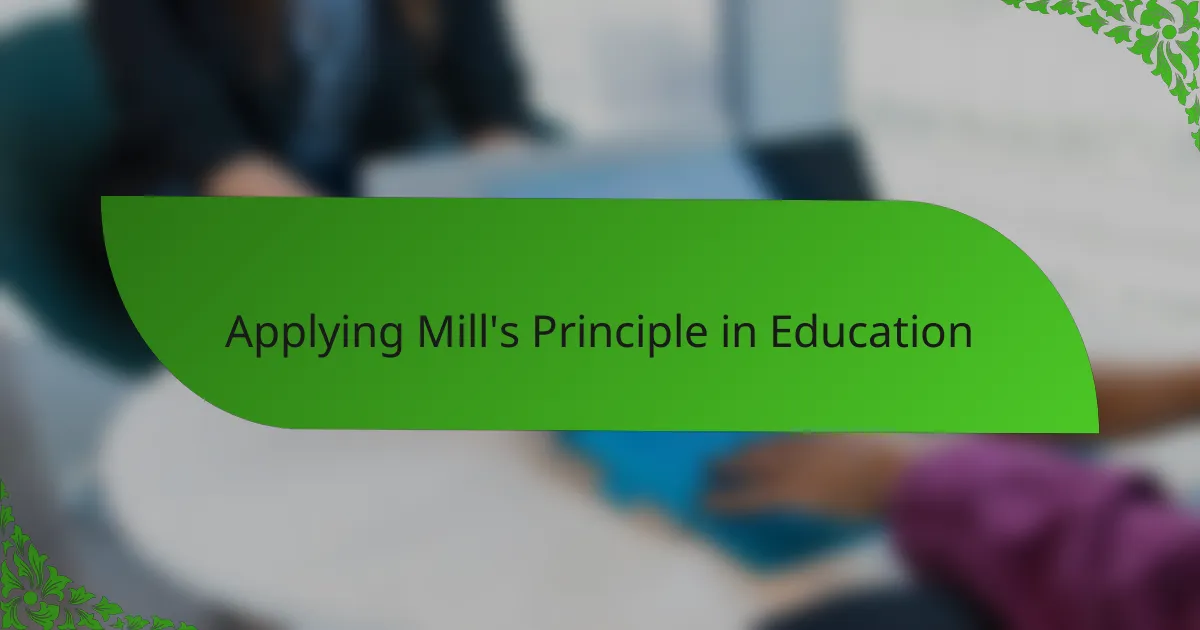
Applying Mill’s Principle in Education
Applying Mill’s Harm Principle in education often feels like walking a tightrope. How much freedom should students have before it starts interfering with the well-being of others? From my experience as a learner and educator, allowing students the liberty to explore ideas—even controversial ones—can enrich the classroom, so long as it doesn’t harm their peers’ right to learn in a safe environment.
Sometimes, I wonder if strict rules in schools suppress creativity unnecessarily. When I reflect on moments when I questioned authority or challenged norms in class, those experiences were crucial for my growth. Mill’s principle reminds us that restrictions should be justified clearly by the potential for harm, not merely by discomfort or dissent.
But then, what about cases where harm isn’t physical but emotional or psychological? I’ve seen how bullying or exclusion can quietly damage a student’s well-being. Applying Mill’s Principle here means educators must carefully balance protecting free expression with preventing such harms—a complex, ongoing negotiation that shapes not just policy but everyday interactions in classrooms.
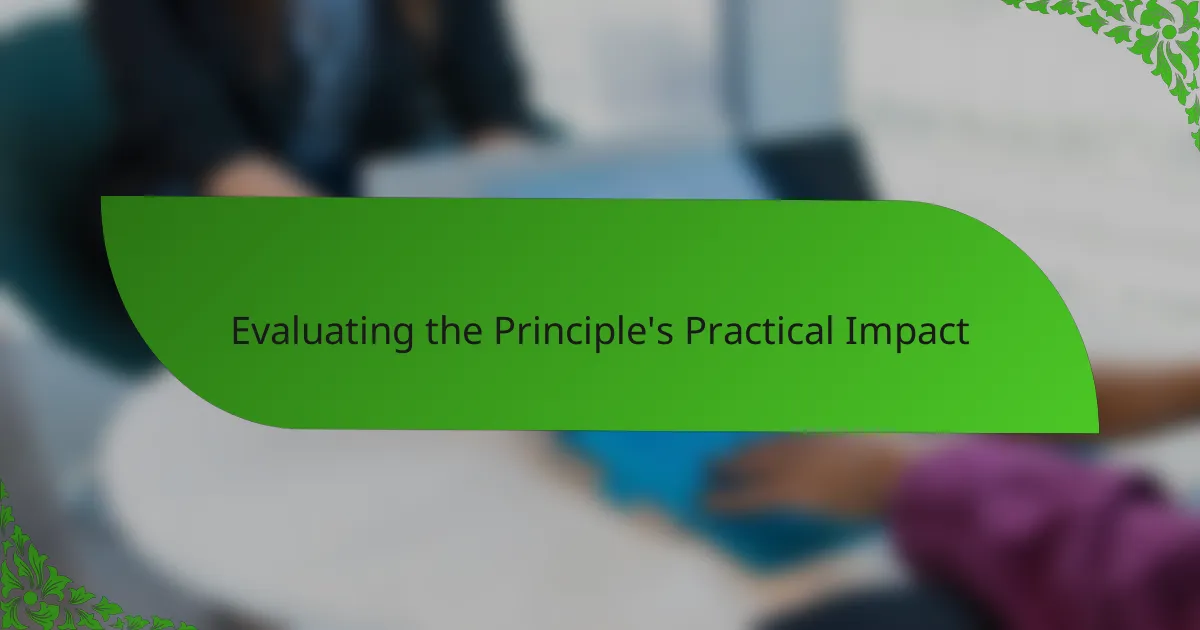
Evaluating the Principle’s Practical Impact
Evaluating the practical impact of Mill’s Harm Principle often leads me to think about real-world policies that claim to protect us. I’ve noticed that sometimes, restrictions meant to prevent harm end up curbing freedoms more than necessary—so I ask myself, are we always clear about who is truly harmed and in what way? This principle challenges us to demand evidence and reason rather than fear-driven control.
In everyday life, I’ve seen the principle’s limits tested when communities try to regulate behaviors that may indirectly affect others, like loud music or public protests. It makes me wonder: can we always draw a clear line between personal liberty and harm to society? The practicality of Mill’s idea depends heavily on our ability to identify harm objectively, which is often messier than theory suggests.
At the same time, I appreciate how the Harm Principle encourages ongoing reflection and dialogue rather than rigid rules. From my perspective, its real power lies not in perfect enforcement but in inspiring us to question the justification behind any limitation on freedom. This process feels both humbling and necessary, reminding me that living with liberty requires constant care and attention to others.
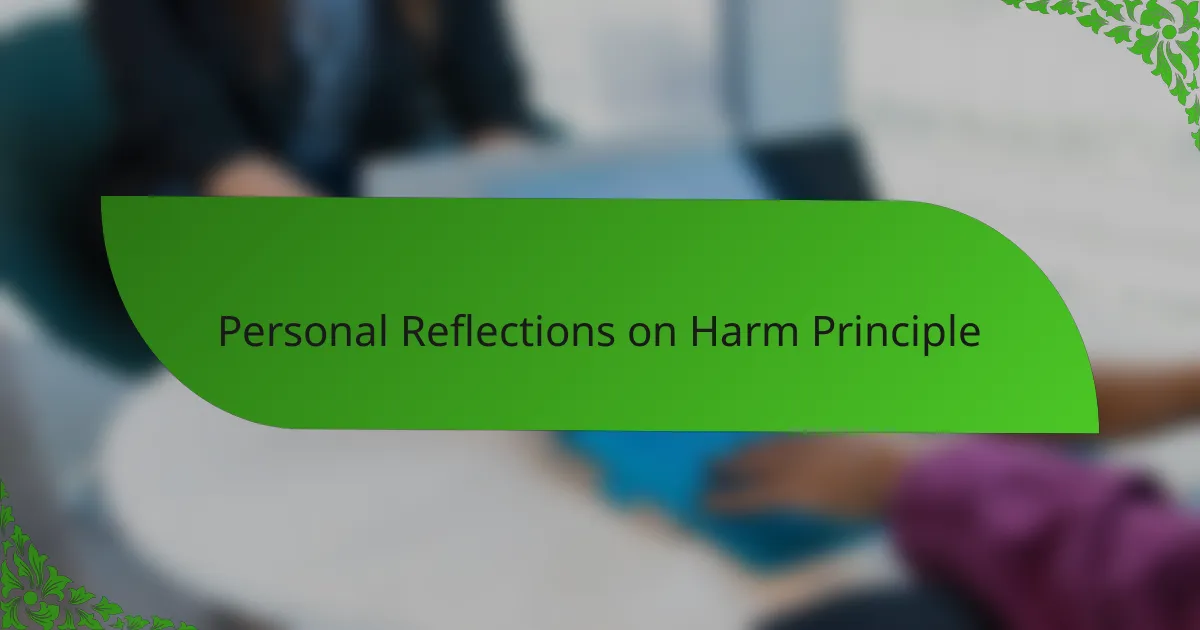
Personal Reflections on Harm Principle
Thinking about the Harm Principle personally, I find it both comforting and challenging. It comforts me because it respects individual freedom deeply, something I value from my own journey toward self-expression. Yet, it challenges me when I consider moments I’ve witnessed where harm isn’t obvious—like subtle social pressures or silent exclusions—making me question how we truly measure harm beyond the physical.
I also reflect on times when I’ve felt torn between standing up for my own choices and respecting others’ boundaries. Have I ever imposed harm unintentionally by pursuing my freedom? These questions make me realize that applying Mill’s principle isn’t a simple checklist but a continuous, sometimes uneasy, conversation with ourselves and those around us.
What strikes me most is how this principle invites humility. It reminds me that no matter how convinced I am about protecting liberty, I must remain open to recognizing harm in its many forms. This balance feels delicate, and I often find myself returning to Mill’s words as a guide to navigate that complexity.
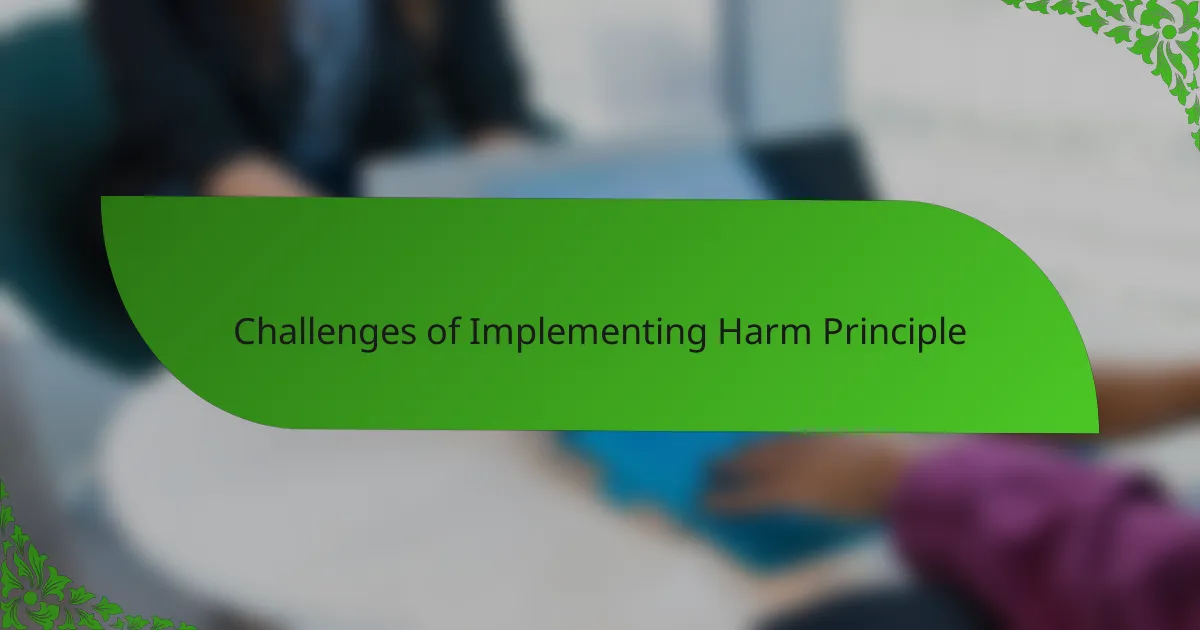
Challenges of Implementing Harm Principle
Implementing Mill’s Harm Principle in real life often feels like trying to capture smoke. How do we pinpoint harm when it’s so subjective? I’ve seen policies meant to prevent harm end up restricting freedoms excessively, mostly because people can’t agree on what counts as harm and who suffers it.
Another hurdle is distinguishing between harm that truly justifies limiting liberty and mere offense or discomfort. I’ve had conversations where someone’s feelings felt hurt, but was that harm enough to restrict their freedom? This gray area makes applying the principle far more complicated than it looks on paper.
From my experience, there’s also the problem of invisible or indirect harms—like social exclusion or misinformation. These don’t leave bruises, yet their impact lingers. It makes me wonder if Mill’s framework can fully address these subtle harms without becoming too invasive or vague.

Conclusion and Future Applications
Looking back on Mill’s Harm Principle, I see it as a powerful starting point rather than a strict rulebook. It pushes me to remain vigilant about the reasons behind limiting freedom and to keep asking: who really gets hurt, and how? This ongoing inquiry feels essential as society faces new ethical challenges.
Looking forward, I believe the principle’s greatest potential lies in education and policy-making, where balancing free expression with protection from harm becomes a daily negotiation. In my experience, embracing this balance requires humility and openness, especially as harm evolves in less visible ways, like emotional or social damage.
Ultimately, applying Mill’s idea in the future invites us all to participate thoughtfully and compassionately in defining our shared boundaries. Can we stay curious enough to update our understandings of harm without sacrificing the core value of liberty? That tension, to me, is where the principle’s lasting relevance shines brightest.